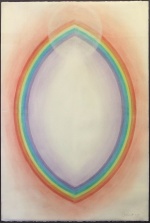Mandorla (art work)

Mandorla is a pastel created by Burton Callicott, a member of the Memphis Lodge of the Theosophical Society in America. It hangs outside the Meditation Room in the L. W. Rogers Building, the headquarters of the TSA in Wheaton, Illinois. The exhibit sign states, "Represents the human aura as an almond-shaped rainbow of the seven human principles. At the top is the white light of atma, in the center – pure emptiness, the holy void from which all comes forth." See the also term mandorla.
The artist donated the work in the year 2000, when he was 93 years old, along with another work, Antahkarana. Callicott experimented with the mandorla form for many years. His family donated an oil version, Mandorla No. 12 , painted in 1989. The dimensions of the pastel are 18.5 x 26 inches, or 47 x 66 cm.
The mandorla is a symbol in many cultures and religions, and the name derives from the Italian word for almond. Late in his life, Callicott wrote a poem:[1]
Two sculptured vertical arcs meeting in points above and below – in the shape of the almond – framing the "Christ in Glory," in high relief enthroned in the tympanum stone above the cathedral's main portal configure the mandorla. So knew they in the Romanesque era of the hidden aura of light and energy – of the subtle bodies the invisible synergy.
Notes
- ↑ Burton Callicott, [poem number] "24" Art & Soul (2020), 50.